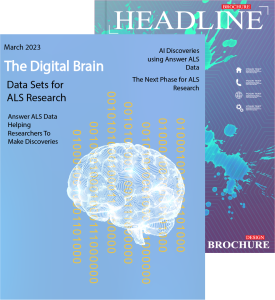
Publications
Answer ALS Publication Policy
- Original Data vs. Derivatives: You may not publish or claim the original data. However, you’re encouraged to publish derivatives or findings resulting from the data.
- Notification of Publications: If you produce publications using AALS samples and datasets, please inform us. We would like to cite your work on other data repository websites.
- Acknowledgments and Citations: In your publications and presentations involving Answer ALS Data or Study Materials Results, kindly acknowledge the Answer ALS program, our funders, and the cohorts who contributed data. This recognition is vital for tracking research outputs from our data—a critical measure for our sponsors.
Below are the general Answer ALS Publications Policy guidelines:
- You are not permitted to publish or claim the original data. Derivatives or findings from the data, however, can be published.
- Whenever you use Answer ALS Data or Study Materials in manuscripts and presentations, ensure you acknowledge the Answer ALS program, its funders, and the contributing cohorts with the appropriate language provided below:
Answer ALS Acknowledgement:
“Data used in the preparation of this article were obtained from the ANSWER ALS Data Portal (AALS-01184). For up-to-date information on the study, visit https://dataportal.answerals.org.
To Cite Answer ALS Description Paper:Baxi, E. G. et al. Answer ALS, a large-scale resource for sporadic and familial ALS combining clinical and multi-omics data from induced pluripotent cell lines. Nat Neurosci 1-12 (2022) doi:10.1038/s41593-021-01006-0.
Answer ALS Cohort Acknowledgements:“Clinical data and biosamples used in the preparation of this article were obtained from the Answer ALS Foundation Program, ‘Answer ALS’. For up-to-date information on the program, visit https://www.answerals.org.
Citations Using Answer ALS Data Sets
- Geraci, J. et al. Machine learning hypothesis-generation for patient stratification and target discovery in rare disease: our experience with Open Science in ALS. Front. Comput. Neurosci. (2024) doi:10.3389/fncom.2023.1199736.
- Grassano, M. et al. Sex Differences in Amyotrophic Lateral Sclerosis Survival and Progression: A Multidimensional Analysis. Ann Neurol. (2024) Jul;96(1):159-169.doi: 10.1002/ana.26933. Epub 2024 Apr 3.
- Cicardi, M.E. et al. The nuclear import receptor Kapβ2 modifies neurotoxicity mediated by poly(GR) in C9orf72-linked ALS/FTD. Communications Biology 7, 376 (2024)
- Kalia, M. et al. Genetic and phenotype analyses of primary lateral sclerosis datasets from international cohorts. medRxiv (2023) doi: https://doi.org/10.1101/2023.07.19.23292817.
- Hasan, M. et al. Identifying dysregulated regions in amyotrophic lateral sclerosis through DNA accessibility outliers. biorxiv (2023) doi: https://doi.org/10.1101/2023.08.25.554881
- Rothstein, J.D. et al. G2C4 targeting antisense oligonucleotides potently mitigate TDP-43 dysfunction in C9orf72 ALS/FTD human neurons. biorxiv (2023) doi: https://doi.org/10.1101/2023.06.26.546581
- Ziff, O. J. et al. Integrated transcriptome landscape of ALS identifies genome instability linked to TDP-43 pathology. Nat Commun 14, 2176 (2023).
- Workman, M. J. et al. Large-scale differentiation of iPSC-derived motor neurons from ALS and control subjects. Neuron (2023) doi:10.1016/j.neuron.2023.01.010.
- Megat, S. et al. Integrative genetic analysis illuminates ALS heritability and identifies risk genes. Nat. Commun. 14, Article number: 342 (2023)
- Çelik, M. H. et al. Aberrant splicing prediction across human tissues. biorxiv 2022.06.13.495326 (2022) doi:10.1101/2022.06.13.495326.
- Baxi, E. G. et al. Answer ALS, a large-scale resource for sporadic and familial ALS combining clinical and multi-omics data from induced pluripotent cell lines. Nat Neurosci 1–12 (2022) doi:10.1038/s41593-021-01006-0.
- Fels, J. A. et al. Gene expression profiles in sporadic ALS fibroblasts define disease subtypes and the metabolic effects of the investigational drug EH301. Hum Mol Genet 31, 3458–3477 (2022).
- Ma, X.R. et al. TDP-43 represses cryptic exon inclusion in the FTD–ALS gene UNC13A. Nature 603, 124–130 (2022). doi:https://doi.org/10.1038/s41586-022-04424-7
- Zhang, S. et al. Genome-wide identification of the genetic basis of amyotrophic lateral sclerosis. Neuron (2022) doi:10.1016/j.neuron.2021.12.019.
- Pun, F. W. et al. Identification of Therapeutic Targets for Amyotrophic Lateral Sclerosis Using PandaOmics – An AI-Enabled Biological Target Discovery Platform. Front Aging Neurosci 14, 914017 (2022).
- Ramamoorthy, D. et al. Identifying patterns in amyotrophic lateral sclerosis progression from sparse longitudinal data. Nat Comput Sci 1–12 (2022) doi:10.1038/s43588-022-00299-w.
- Versluys, L. et al. Expanding the TDP-43 Proteinopathy Pathway From Neurons to Muscle: Physiological and Pathophysiological Functions. Front Neurosci. (2022) doi: 10.3389/fnins.2022.815765.
- Gilley, J. et al. Enrichment of SARM1 alleles encoding variants with constitutively hyperactive NADase in patients with ALS and other motor nerve disorders. Medrxiv 2021.06.17.21258268 (2021) doi:10.1101/2021.06.17.21258268.
- Consortium, T. N. et al. An integrated multi-omic analysis of iPSC-derived motor neurons from C9ORF72 ALS patients. Iscience 24, 103221 (2021).
- Coyne, A. N. et al. Nuclear accumulation of CHMP7 initiates nuclear pore complex injury and subsequent TDP-43 dysfunction in sporadic and familial ALS. Sci Transl Med 13, eabe1923 (2021).
- Coyne, A. & Rothstein, J. The ESCRT-III protein VPS4, but not CHMP4B or CHMP2B, is pathologically increased in familial and sporadic ALS neuronal nuclei. Acta Neuropathologica Commun 9, 127. (2021)
- Coyne, A. N. & Rothstein, J. D. Nuclear lamina invaginations are not a pathological feature of C9orf72 ALS/FTD. Acta Neuropathologica Commun 9, 45 (2021).
- Andrews, J.A. et al. Amyotrophic lateral sclerosis care and research in the United States during the COVID-19 pandemic: Challenges and opportunities. Muscle Nerve. (2020) doi: 10.1002/mus.26989.
- Course, M. M. et al. Evolution of a Human-Specific Tandem Repeat Associated with ALS. Am J Hum Genetics 107, 445–460 (2020).
- Agurto, C. et al. Analyzing progression of motor and speech impairment in ALS. 2019 41st Annu Int Conf Ieee Eng Medicine Biology Soc Embc 00, 6097–6102 (2019).
- Nicolas, A. et al. Genome-wide Analyses Identify KIF5A as a Novel ALS Gene. Neuron 97, 1268-1283.e6 (2018).